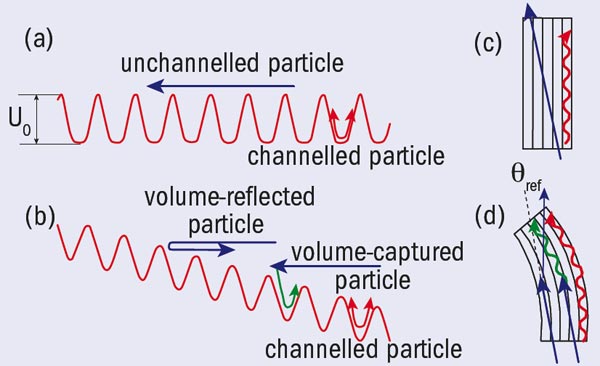A team working at CERN has detected the phenomenon of volume reflection using bent silicon crystals with a 400 GeV proton beam at the Super Proton Synchrotron. The efficiency achieved was greater than 95%, over a much wider angular acceptance than is possible with particle channelling in bent crystals. This effect could prove valuable in manipulating beams at the next generation of high-energy particle accelerators.

Using the ordered structure of a crystal lattice to guide high-energy particle beams is already finding applications through the effect of particle channelling. In channelling a charged particle becomes confined in the potential well between planes of the crystal lattice, and if the crystal is bent, the effect can be used to change the particle’s direction (figure 1). However, to be channelled in this way, the particle must have a small transverse energy, less than that of the confining potential well. In a bent crystal, a particle with higher transverse energy may also change direction: it may lose some transverse energy and then become captured, or it may have its transverse direction reversed in an elastic interaction with the potential barrier. This latter process, which changes the particle’s direction, is known as volume reflection – and it is this effect that dominates, and therefore becomes more interesting, at higher energies.
In the research at CERN, a team from institutes in Italy, Russia and the US mounted a silicon-strip crystal on a high-precision goniometer. A specially designed holder kept the (110) crystal planes bent at an angle of 162 μrad along the crystal’s 3 mm length in the beam direction. Various detectors mapped the trajectory of the particles along the beam line and measured their fluxes.

Figure 2 shows the horizontal deflection of particles, as measured 64.8 m downstream, for a range of crystal orientations. The effect of channelling is clearly visible when the crystal orientation is about 0.06 mrad, giving a deflection of 165 μrad, which corresponds to the bending angle of the crystal. Here about 55% of the particles were deflected. At larger orientations, this effect disappears as the beam can no longer enter the silicon between the crystal planes. Instead a smaller beam deflection, in the opposite direction, is seen. Here the measured deflection angle of 13.9 ± 0.2 (stat.) ± 1.5 (syst.) μrad agrees well with the calculated prediction for volume reflection of 14.5 μrad. This deflection occurs over a wide range of crystal orientations, corresponding to the bending angle of the crystal; beyond this the crystal appears amorphous and the beam no longer “sees” the (110) layers.
A preliminary analysis indicates an efficiency greater than 95% for volume reflection, which occurs over a far greater range of angles than channelling. This, the team says, suggests new perspectives for the manipulation of high-energy beams, for example for collimation and extraction in high-energy hadron colliders, such as the LHC. For example, a short bent crystal could be used as a “smart” deflector to aid halo collimation in a high-intensity hadron collider, or as a device to separate low-angle scattering events in diffractive physics, close the beam line.







